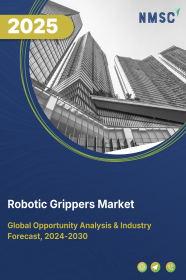
Robotics Grippers Market by Type (Vacuum Grippers, Pneumatic Grippers, Hydraulic Grippers, Servo-Electric Grippers, Electromagnetic Grippers), by Configuration (Two-Finger, Three-Finger, Angular Grippers, Two-JawThree-Jaw), by Application (General Assembly, Material Handling, Inspection, Others), by End-User (Automotive & Transportation, Electronics, Semiconductors, Logistics, Food & Beverage, Pharmaceuticals, Packaging)- Global Opportunity Analysis and Industry Forecast 2024-2030
Industry: ICT & Media | Publish Date: 21-Mar-2025 | No of Pages: 433 | No. of Tables: 328 | No. of Figures: 273 | Format: PDF | Report Code : IC511
US Tariff Impact on Robotic Grippers Market
Trump Tariffs Are Reshaping Global Business
Market Definition
The Robotic Grippers Market size was valued at USD 1.5 billion in 2023 and is predicted to reach USD 3.07 billion by 2030 with a CAGR of 10.1% from 2024-2030.
Robotics grippers are mechanical devices designed to grasp, hold, and manipulate objects in various applications, replicating the function of human hands. They are a crucial component of robotic systems, allowing robots to interact with their environment, perform tasks, and execute complex operations autonomously. Grippers come in different types and designs, ranging from simple mechanical claws to advanced robotic hands equipped with sensors and actuators for precise and dexterous manipulation of objects.
Market Dynamics and Trends
The global robotic grippers market is witnessing significant growth driven by the increasing adoption of automation across various industries such as manufacturing, automotive, electronics, and healthcare. With the growing demand for efficiency, productivity, and precision in manufacturing processes, companies are increasingly turning to robotic systems equipped with advanced grippers to streamline operations and improve production outcomes. A pivotal catalyst driving the market's expansion is the pronounced surge in the installation of industrial robots worldwide.
According to the World Robotics 2023 Industrial Robots and Service Robots report, an impressive 553,052 industrial robots were installed in factories across the globe in 2022, reflecting a robust year-over-year growth rate of 5%. This surge underscores the pervasive adoption of automation technologies, including robotic grippers, as integral components of contemporary manufacturing ecosystems.
Additionally, the rise of e-commerce and logistics sectors is fueling the demand for robotic grippers, particularly in material handling and warehouse automation applications. As the volume of online orders continues to surge, companies are investing in robotic systems to automate order fulfillment processes, optimize inventory management, and enhance operational efficiency.
Robotic grippers play a crucial role in handling various types of products and packages, ranging from small items to bulky goods, in dynamic warehouse environments. Moreover, advancements in robotic technology, including the development of collaborative robots (cobots) and advanced sensors, are expanding the capabilities and applications of robotic grippers. These technological innovations enable robots to perform a wider range of tasks with greater flexibility and accuracy, driving the demand for versatile gripper solutions in diverse industries.
However, the upfront investment required for acquiring and integrating robotic grippers into existing manufacturing setups can be substantial, particularly for small and medium-sized enterprises (SMEs) with limited financial resources. The capital expenditure involved in deploying robotic automation solutions often acts as a deterrent for potential adopters, restricting market penetration and adoption rates.
On the other hand, the convergence of robotic grippers with advanced technologies such as AI and machine learning opens up new possibilities for intelligent and adaptive gripping solutions. AI-powered robotic grippers equipped with machine vision capabilities can recognize and adapt to variations in object shapes, sizes, and materials, enabling more flexible and versatile handling tasks. These intelligent grippers can autonomously adjust their grip force, trajectory, and orientation based on real-time feedback, optimizing performance and minimizing errors in complex manufacturing environments.
Market Segmentation and Scope of Study
The global robotics grippers market is segmented on the basis of type, application, end-use industry, and geography. Based on type, the market is classified into vacuum grippers, pneumatic grippers, hydraulic grippers, servo-electric grippers. Based on the application, the market is segmented into general assembly, material handling, inspection, and others. On the basis of end use industry, the market is categorized into automotive & transportation, electronics & semiconductors, chemical & pharmaceutical, logistics, food & beverages, healthcare. Geographical breakdown and analysis of each of the aforesaid classifications include regions comprising of North America, Europe, Asia-Pacific, and RoW.
Geographical Analysis
North America dominates the global robotics grippers market and is potently expected to remain dominant in the market throughout the forecast period. This is attributed to the rising adoption of robotic grippers in various industries such as automobile and logistics in the region.
According to a report published by Association for Advancing Automation in February 2022, around 39,708 units of robots, valued at USD 2 billion were installed in North America in 2021. Additionally, technological advancements and research initiatives in the field of robotics and automation contribute to the growth of the robotic grippers market in North America.
The region boasts a thriving ecosystem of research institutions, universities, and technology companies that are at the forefront of developing cutting-edge gripper technologies. Collaborative efforts between academia and industry drive innovation in gripper design, functionality, and performance, enabling North American manufacturers to access state-of-the-art solutions that enhance their competitiveness in the global market.
Moreover, the presence of key market players in the region such as ATI Industrial Automation, Applied Robotics and others which are driving innovation and expansion in the region are fueling the growth of the market. For example, Applied Robotics introduced a new line of electric grippers in May 2022, aimed at addressing automation challenges without relying on air systems. These grippers are engineered to deliver the same level of precision and reliability while reducing energy consumption, thereby appealing to a wide range of industries seeking more sustainable automation solutions.
On the other hand, the Asia Pacific region continues to be a driving force in the global robotic grippers market, with significant growth attributed to robust demand and adoption of robotics technologies across various industries. According to the International Federation of Robotics (IFR), Asia accounted for 73% of all newly deployed robots in 2022, with China leading the way in terms of market size and growth. China stands out as the largest market for robotics globally, accounting for a substantial portion of the region's installations. In 2022, annual robot installations in China reached 290,258 units, representing a remarkable 5% increase from the previous year. This surge in installations underscores China's commitment to automation and its rapid industrialization efforts. The country's strong manufacturing base, coupled with government initiatives to promote automation and innovation, has fueled the adoption of robotic technologies across various sectors, including automotive, electronics, and logistics.
Furthermore, Japan also witnessed significant growth in robot installations, reflecting the country's continued focus on technological advancement and industrial automation. Annual installations in Japan rose by 9% to 50,413 units in 2022, surpassing pre-pandemic levels recorded in 2019. This resurgence in robot deployments highlights the region’s resilience and adaptability in leveraging robotics to enhance manufacturing efficiency and competitiveness.
Competitive Landscape
The robotics grippers market includes several market players such as Robotiq Inc, ABB Ltd., SCHUNK SE & Co. KG, KUKA AG, OnRobot A/S, DESTACO, Festo , Weiss Robotics GmbH & Co. KG, Schmalz, Dorna Robotics, SMC Corporation, Kawasaki Heavy Industries, Ltd., ZIMMER GROUP, LH-TC Co.,Ltd, Association for Advancing Automation. These market players are adopting various strategies such as innovation and collaboration to maintain their dominance in the global robotics grippers market.
For instance, in September 2023, Robotiq Inc. unveiled its latest addition to its product lineup, the PE20 palletizing system. This system features Robotiq's PowerPick20 vacuum gripper, renowned for its exceptional performance and versatility. With a high payload to weight ratio, the gripper enables users to maximize the net UR20 lift capacity to 18 kg.
Moreover, in March 2023, Destaco unveiled a new portfolio of end-of-arm tooling (EOAT), designed to help customers using collaborative robots and small-payload robots. The tools can be used to complete gripping, palletizing, machine tending, tool changing, and tool-extension applications.
Key Benefits
-
The robotics grippers market report provides the quantitative analysis of the current market and estimations through 2024-2030 that assists in identifying the prevailing market opportunities to capitalize on.
-
The study comprises a deep dive analysis of the robotics grippers market trend including the current and future trends for depicting the prevalent investment pockets in the market.
-
The information related to key drivers, restraints and opportunities and their impact on the robotics grippers market is provided in the report.
-
The competitive analysis of the market players along with their market share in the robotics grippers market
-
The SWOT analysis and Porters Five Forces model is elaborated in the study.
-
Value chain analysis in the market study provides a clear picture of the stakeholders’ roles.
Key Market Segments
By Type
-
Vacuum Grippers
-
Pneumatic Grippers
-
Hydraulic Grippers
-
Servo-Electric Grippers
-
Electromagnetic Grippers
By Configuration
-
Two-Finger
-
Three-Finger
-
Angular Grippers
-
Two-Jaw
-
Three-Jaw
By Application
-
General Assembly
-
Material Handling
-
Inspection
-
Others
By End-User
-
Automotive & Transportation
-
Electronics
-
Semiconductors
-
Logistics
-
Food & Beverage
-
Pharmaceuticals
-
Packaging
By Region
-
North America
-
U.S
-
Canada
-
Mexico
-
-
Europe
-
UK
-
Germany
-
France
-
Italy
-
Spain
-
Denmark
-
Netherlands
-
Finland
-
Sweden
-
Norway
-
Russia
-
Rest of Europe
-
-
Asia-Pacific
-
China
-
Japan
-
India
-
South Korea
-
Australia
-
Indonesia
-
Singapore
-
Taiwan
-
Thailand
-
Rest of Asia-Pacific
-
-
Rest of the World (RoW)
-
Latin America
-
Middle East
-
Africa
-
Key Players
-
Robotiq Inc
-
ABB Ltd.
-
SCHUNK SE & Co. KG
-
KUKA AG
-
OnRobot A/S
-
DESTACO
-
Festo
-
Weiss Robotics GmbH & Co. KG
-
Schmalz
-
Dorna Robotics
-
SMC Corporation
-
Kawasaki Heavy Industries, Ltd.
-
ZIMMER GROUP
-
LH-TC Co.,Ltd
-
Association for Advancing Automation
REPORT SCOPE AND SEGMENTATION:
|
Parameters |
Details |
|
Market Size in 2023 |
USD 1.5 Billion |
|
Revenue Forecast in 2030 |
USD 3.07 Billion |
|
Revenue Growth Rate |
CAGR of 10.1% from 2024 to 2030 |
|
Analysis Period |
2023–2030 |
|
Base Year Considered |
2023 |
|
Forecast Period |
2024–2030 |
|
Market Size Estimation |
Billion (USD) |
|
Growth Factors |
|
|
Countries Covered |
28 |
|
Companies Profiled |
15 |
|
Market Share |
Available for 10 companies |
|
Customization Scope |
Free customization (equivalent up to 80 working hours of analysts) after purchase. Addition or alteration to country, regional, and segment scope. |
|
Pricing and Purchase Options |
Avail customized purchase options to meet your exact research needs. |

















 Speak to Our Analyst
Speak to Our Analyst





















